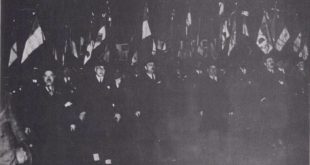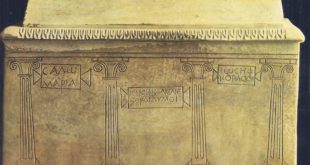ON NOVEMBER 8, 1923, about three thousand men were sitting at the tables of a large beer hall on the outskirts of Munich. They had come this evening not just to drink beer; they were to hear a speech by Gustave von Kahr. He was the head of the government of Bavaria, one of the states of Germany. Conditions had been bad in Germany since the end of World War I and Kahr’s audience was anxious to learn what the government intended to do.
Kahr was still speaking when there was a commotion at the back of the ball. Several men had come in and one of them leaped up on a table and fired a pistol into the air. He wore his hair combed down over one eye and had a small moustache that resembled Charlie Chaplin’s.
Kahr recognized him. His name was Adolph Hitler. He was the head of a political group, the National Socialist German Workers party, whose members were usually called Nazis.
Hitler and his companions pushed their way to the speaker’s platform, where Hitler shouted, “The National Revolution has begun!” The building was surrounded by his brown-shirted storm troopers, their machine guns ready. Soon, he said, the Nazi flag with its black swastika would be flying over Bavaria. Then the Nazis would march on Berlin and take over all of Germany.

As it happened, Hitler was a bit too optimistic. He would not take over Germany quite that soon. Forcing Kahr and two other important government officials into a back room, Hitler threatened them with his pistol. He thought he had won them over and could expect their help, but again he was mistaken. In the confusion they managed to slip away and Kahr issued an order dissolving the Nazi party.
The next day, disappointed but still hopeful, Hitler led 3,000 of his storm troopers against the building of the War Ministry. It was guarded by a detachment of armed police who refused to give way. A shot was fired — by which side, no one knew — and firing by both sides followed. Although the shooting lasted for no more than a minute, sixteen Nazis and three policemen were killed and a number wounded. Like the other Nazis, Hitler had immediately thrown himself to the ground to avoid being hit and he was the first to get up and run to safety. Reaching a car that was waiting for him, he was driven off to the house of a friend.
During the next few days, the police searched for the Nazi leaders. Two of them, Herman Goering and Rudolph Hess, escaped to Austria. Hitler and the rest were arrested and jailed. The beer hall revolution, which became known as the “beer hall putsch‚” had failed, but Germany and the world — had not heard the last of Adolph Hitler.
CORPORAL HITLER
In February of 1924, Hitler went on trial for high treason. Newspapermen from various countries were in the courtroom and Hitler saw that this was his chance to make himself known far beyond Bavaria. The judges had received their instructions from the Minister of Justice, who was a friend and supporter of Hitler and they let him do much as he pleased. Often he spoke for hours at a time. He attacked the government of Germany, predicted that it would be overthrown and proclaimed that the country would be ruled by the Nazis. The judges found him guilty and by law the punishment for high treason was life imprisonment, but he was given a sentence of five years and he would actually be freed in less than nine months.

The trial was wider reported and it made Hitler’s name known throughout the world. People began to wonder: Who was this strange man with the little moustache and his hair combed down over one eye? What did he want? Where did he come from?
Although he had said that someday he would be ruler of all Germany, Hitler was not a German. He was a Citizen of Austria, where he had been born, near the German border, on April 20, 1889. His father was a customs official of little importance. Hitler failed to graduate from high school, but his best subject was drawing and his ambition was to be a painter. Twice he applied for admission to the Vienna Academy of Fine Arts and twice he was turned down. He was told that he simply did not have enough talent to become an artist.
At the age of twenty, after both his father and his mother had died, Hitler settled in Vienna. For the next four years he lived the life of a vagabond and was often hungry. He did all sorts of odd jobs. Among other things, he painted and sold crude pictures of Viennese scenes and commercial posters. Shabby and dirty, he was already beginning to form the ideas which would later influence so many people. He considered himself a German and he had a strong feeling for Germany as a nation. Just as strong were his feelings about Marxists and Jews. He hated them both, especially the Jews.
Leaving Vienna, Hitler went to Germany, where he was living when World War 1 began in 1914. He welcomed the war and volunteered for the army. Here was his chance to serve the country he admired so much. Besides, in the army he would no longer be an outcast. Later he wrote, “I sank down on my knees and thanked Heaven out of the fullness of my heart for granting me the good fortune of being permitted to live in such a time. . . .”
Hitler proved to be a good soldier. Although he never rose above the rank of corporal, he was given a medal — the Iron Cross, First Class — for bravery. He was once wounded in the leg and shortly before the end of the war he was temporarily blinded by gas. He was still in the hospital when he learned that Germany had surrendered and the kaiser had given up his throne.
How was it possible? How could it have happened? How had the great and mighty Germany gone down to defeat? Shocked and horrified, Hitler burst into tears.




